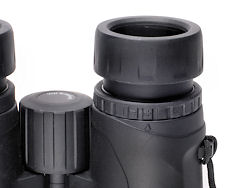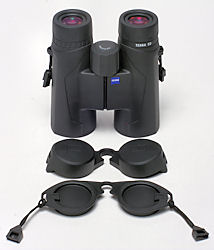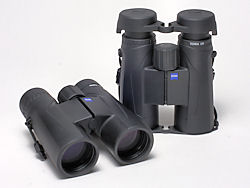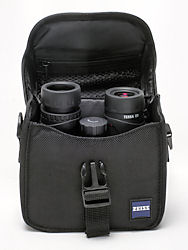Zeiss Terra ED 42mm Binoculars
|
|
Review Highlights
- Zeiss’s inexpensive nature-watching binocular
- Schott ED glass for bright, sharp images
- 5.3-foot minimum close focus!
- Lightweight and compact for a 42-mm binocular
|
When Zeiss announced the arrival of a new low-cost 42mm binocular at the beginning of 2017, we were really curious about it.
It’s been many years since any full-sized Zeiss binocular sold for much under $1000, and suddenly they released
an ED glass optic in the $499.99 to $499.99 range.
This was, if you will, Terra incognita for us all. We had talked with other high-end
optics manufacturers about doing something like this, and every one of them said they wouldn’t dilute their brand
that way. The question is, can you actually manufacture a quality optic worthy of a venerable name at this price level?
Evidently, most companies thought not. Zeiss thought otherwise, and the result was the 42-mm Terra ED binoculars at 8x and 10x.
Since then Zeiss has added gray rubber armoring, 32mm models, and 25mm pocket-sized binoculars. This review concentrates on the 42s.
Glass
and Coatings
When talking about an inexpensive ED glass binocular, it’s logical to start with the glass. ED is just one of the various
acronyms used to describe such glass, usually translated as Extra-low Dispersion. Not every binocular that has the letters ED
or HD in its name is actually made with high-density/extra-low dispersion glass. This material is more expensive, and true to
its name, it is heavier. Moreover, it’s actually only made in a few places around the world. Zeiss uses ED glass exclusively
from the renowned Schott glass company, and it’s the real thing. Whenever light passes through glass, it gets prismatically
dispersed some because the different light wavelengths bend at slightly different angles from each other. Extra-low dispersion
glass contains heavy metal elements that help to keep these light wavelengths together better. This means that you get less of
the color fringing on the edges of brightly lit or high-contrast objects. We may not even see the fringing, but we perceive such
images as being more blurry, lacking the razor sharpness we like. This, in turn, promotes eye fatigue over longer periods of use.
ED glass helps produce sharper image quality. Since the Terras are roof prism binoculars, they are also phase-coated to eliminate
another source of color-muddying and loss of sharpness. Additionally, Terra ED binoculars are fully multi-coated with Zeiss’
proprietary MC multi-coating.
Optical
Characteristics
 In terms of their other optical properties, the Terras are overall average or slightly better than average. The 8x42 model has
a 375-foot field of view at 1000 yards, which is a little bit better than average on a full-sized 8x roof prism. The 10x42s come
in at 330 feet, which pretty much is the average for that binocular class. The Terras have a little bit of a soft edge to the
visual field, but the sweet spot of really sharp focus in the center of the field is quite large, notably larger than that of
several other binoculars in the same price class. Minimum close focus for both Terra models is a respectable 5.3 feet, which
is better than average, and by a significant amount. Most roof prism binoculars don’t close focus to under 6 feet although
the trend on this is shortening with time. We found the overall clarity and sharpness of the Terras to be very good but not superb.
It may be that we’re just spoiled from all the other Zeiss binoculars we’ve looked through, or it may simply be that
we need to recalibrate and remind ourselves that this is a $400 binocular rather than a $1000 one. When you put the Terra in its
rightful class, the performance is really very solid and competes well with everything else in its market niche. The color is
completely neutral, without any trace of bias. The brightness is very good. The Terras go from minimum close focus to infinity
in 1.5 turns of the focus knob, which is just about right. Focusing is very facile and really smooth. Many people like a bit more
resistance in their focus than these have, but for our tastes, this is just about perfect! We noted that the Terras also have
pretty good depth of field, notably better than several of their competitors.
In terms of their other optical properties, the Terras are overall average or slightly better than average. The 8x42 model has
a 375-foot field of view at 1000 yards, which is a little bit better than average on a full-sized 8x roof prism. The 10x42s come
in at 330 feet, which pretty much is the average for that binocular class. The Terras have a little bit of a soft edge to the
visual field, but the sweet spot of really sharp focus in the center of the field is quite large, notably larger than that of
several other binoculars in the same price class. Minimum close focus for both Terra models is a respectable 5.3 feet, which
is better than average, and by a significant amount. Most roof prism binoculars don’t close focus to under 6 feet although
the trend on this is shortening with time. We found the overall clarity and sharpness of the Terras to be very good but not superb.
It may be that we’re just spoiled from all the other Zeiss binoculars we’ve looked through, or it may simply be that
we need to recalibrate and remind ourselves that this is a $400 binocular rather than a $1000 one. When you put the Terra in its
rightful class, the performance is really very solid and competes well with everything else in its market niche. The color is
completely neutral, without any trace of bias. The brightness is very good. The Terras go from minimum close focus to infinity
in 1.5 turns of the focus knob, which is just about right. Focusing is very facile and really smooth. Many people like a bit more
resistance in their focus than these have, but for our tastes, this is just about perfect! We noted that the Terras also have
pretty good depth of field, notably better than several of their competitors.
Physical
Properties
 The Terras have quite a compact frame, especially if you’re used to the tall feel of other Zeiss binoculars. The Terras measure
just 5.9 inches tall with the eyecups fully extended (5.5 inches, folded down). The smaller frame corresponds to a lighter weight, as
the 8x Terras weigh just 26.3 ounces with rainguard and lens caps on (24.6 ounces without the covers). The 10x model is slightly lighter
at 26.1 ounces. The compact size and lighter weight make them very comfortable to carry and handle. Eye relief on the Terra is 18 mm on
the 8x42 model and 14 mm on the 10x42. Once again, that’s about average for the 8x but a little bit on the short side for the 10x.
The interpupillary distance range of the Terras is shifted towards the high side, ranging from 57.5 – 76 mm. This means that people
with really narrow faces may not find the Terras completely comfortable, but by the same measure, those with wider than average faces will
find the Terras more comfortable than other binoculars. For the bulk of the potential users out there, however, this range more than covers
them and they’ll be just fine. The balance of weight in the Terras is just right, so they sit in the hands fairly comfortable. There’s
not a lot of molding in the rubber armoring: no dramatic thumb grooves or flanges that fit against the webbing between forefinger and thumb. It’s
just basic black rubber armoring with a ridge along the upper side of the barrels that falls naturally on your palm just where you bend your fingers.
That does impart more comfort in the hand.
The Terras have quite a compact frame, especially if you’re used to the tall feel of other Zeiss binoculars. The Terras measure
just 5.9 inches tall with the eyecups fully extended (5.5 inches, folded down). The smaller frame corresponds to a lighter weight, as
the 8x Terras weigh just 26.3 ounces with rainguard and lens caps on (24.6 ounces without the covers). The 10x model is slightly lighter
at 26.1 ounces. The compact size and lighter weight make them very comfortable to carry and handle. Eye relief on the Terra is 18 mm on
the 8x42 model and 14 mm on the 10x42. Once again, that’s about average for the 8x but a little bit on the short side for the 10x.
The interpupillary distance range of the Terras is shifted towards the high side, ranging from 57.5 – 76 mm. This means that people
with really narrow faces may not find the Terras completely comfortable, but by the same measure, those with wider than average faces will
find the Terras more comfortable than other binoculars. For the bulk of the potential users out there, however, this range more than covers
them and they’ll be just fine. The balance of weight in the Terras is just right, so they sit in the hands fairly comfortable. There’s
not a lot of molding in the rubber armoring: no dramatic thumb grooves or flanges that fit against the webbing between forefinger and thumb. It’s
just basic black rubber armoring with a ridge along the upper side of the barrels that falls naturally on your palm just where you bend your fingers.
That does impart more comfort in the hand.
Adjustable
Features
 The diopter adjustment is of the most basic kind: a rubber twist-ring situated below the right hand ocular lens. There is no scale on either
the knob or the binocular frame below it to indicate just how much adjustment is being made. In fact, there isn’t even a clearly marked
center point to denote the position for equal eyes. Rather, you just center the raised triangular marking on the armoring on the gap between
the plus and minus signs on the diopter adjustment ring. The consequence of this is that if you require a special position for the knob, there
is no way to know where that position is unless you mark it yourself, and we actually advise users to do this. The diopter adjustment ring does
not lock, so it is a virtual certainty that the position will get lost at some point, forcing you to go through the laborious process of re-locating
the right setting, unless you have marked it. A simple line drawn with a Sharpie or a dot of nail polish would do it. The eyecups adjust with the
now universal helical twist mechanism, clockwise to collapse them, counter-clockwise to extend them. There are no detents to mark positions intermediate
between fully in and fully out, but there is enough resistance in the twist mechanism that intermediate positions should be stable. Getting them exactly
equal between the two eyecups would be the trick, and it’s not necessarily a simple one.
The diopter adjustment is of the most basic kind: a rubber twist-ring situated below the right hand ocular lens. There is no scale on either
the knob or the binocular frame below it to indicate just how much adjustment is being made. In fact, there isn’t even a clearly marked
center point to denote the position for equal eyes. Rather, you just center the raised triangular marking on the armoring on the gap between
the plus and minus signs on the diopter adjustment ring. The consequence of this is that if you require a special position for the knob, there
is no way to know where that position is unless you mark it yourself, and we actually advise users to do this. The diopter adjustment ring does
not lock, so it is a virtual certainty that the position will get lost at some point, forcing you to go through the laborious process of re-locating
the right setting, unless you have marked it. A simple line drawn with a Sharpie or a dot of nail polish would do it. The eyecups adjust with the
now universal helical twist mechanism, clockwise to collapse them, counter-clockwise to extend them. There are no detents to mark positions intermediate
between fully in and fully out, but there is enough resistance in the twist mechanism that intermediate positions should be stable. Getting them exactly
equal between the two eyecups would be the trick, and it’s not necessarily a simple one.
Caps, Strap
and Case
 Zeiss took rather an interesting route with the lens caps and rainguard. The rainguard is actually quite well executed, featuring a pair of deep
and very pliable rubber cups joined by a sturdy linker. The rainguard fits deeply over the eyecups such that it does not dislodge accidentally,
even if the binocular is inverted and shaken hard. A bracket on either side of the rainguard permits the strap to thread through. Neither bracket
is gapped to render it detachable, so if you want to be able to swing the rainguard out of the way, you must attach the strap on only one side.
The objective lens caps are made of the same pliable rubber and are designed to fit into the rubber armoring on the objective ends of the binoculars,
and like the rainguard, the caps are joined by a pliable linking region. Frankly, we’re not completely enamored of this design, though we’ve
seen it executed much worse. In this case, the flange on the end caps fits into the armoring easily enough, but the linker region doesn’t flex as
well as on the rainguard, and often, while trying to fit the second one, the first one pops out. One thing thing we did like was that Zeiss included a
double tether mechanism for the objective caps, with little cords that attach to the strap lug on each side. The cords are broken by a double-toothed
clasp mechanism that allows them to be detached on one or both sides. It’s kind of neat, if a little overly complex. The case is another of those
interesting new ideas. Zeiss doesn’t include a traditional case with the binocular, though one can be obtained from Zeiss. Instead, they included
a velvet drawstring bag that that will serve to keep the binocular clean and dust-free when in storage, but doesn’t offer much in the way of shock-proofing.
Zeiss does make a traditional cordura case for the Terra, and it is available from some optics retailers, though not all of them. Optics4Birding ships
a Zeiss case free with every Terra ED order. The neck strap included with the binocular is the usual hybrid of foam padding and cordura strap. It is comfortable
enough on a binocular this light.
Zeiss took rather an interesting route with the lens caps and rainguard. The rainguard is actually quite well executed, featuring a pair of deep
and very pliable rubber cups joined by a sturdy linker. The rainguard fits deeply over the eyecups such that it does not dislodge accidentally,
even if the binocular is inverted and shaken hard. A bracket on either side of the rainguard permits the strap to thread through. Neither bracket
is gapped to render it detachable, so if you want to be able to swing the rainguard out of the way, you must attach the strap on only one side.
The objective lens caps are made of the same pliable rubber and are designed to fit into the rubber armoring on the objective ends of the binoculars,
and like the rainguard, the caps are joined by a pliable linking region. Frankly, we’re not completely enamored of this design, though we’ve
seen it executed much worse. In this case, the flange on the end caps fits into the armoring easily enough, but the linker region doesn’t flex as
well as on the rainguard, and often, while trying to fit the second one, the first one pops out. One thing thing we did like was that Zeiss included a
double tether mechanism for the objective caps, with little cords that attach to the strap lug on each side. The cords are broken by a double-toothed
clasp mechanism that allows them to be detached on one or both sides. It’s kind of neat, if a little overly complex. The case is another of those
interesting new ideas. Zeiss doesn’t include a traditional case with the binocular, though one can be obtained from Zeiss. Instead, they included
a velvet drawstring bag that that will serve to keep the binocular clean and dust-free when in storage, but doesn’t offer much in the way of shock-proofing.
Zeiss does make a traditional cordura case for the Terra, and it is available from some optics retailers, though not all of them. Optics4Birding ships
a Zeiss case free with every Terra ED order. The neck strap included with the binocular is the usual hybrid of foam padding and cordura strap. It is comfortable
enough on a binocular this light.
Conclusions
So, to summarize, the Terra is a very inexpensive, ED glass, roof prism binocular, that brings better than average optical performance down to a level more
affordable to many birders. No, this doesn’t perform like a $1000-plus binocular, but that really isn’t the point. The Terra competes very effectively
with other binoculars in this price range, and it carries both the Zeiss name, and the support of that respected optics company. We don’t think Zeiss has
diluted their brand at all with this one. In fact, we think they’re on Terra firma with it!
Buy Zeiss Terra ED Binoculars